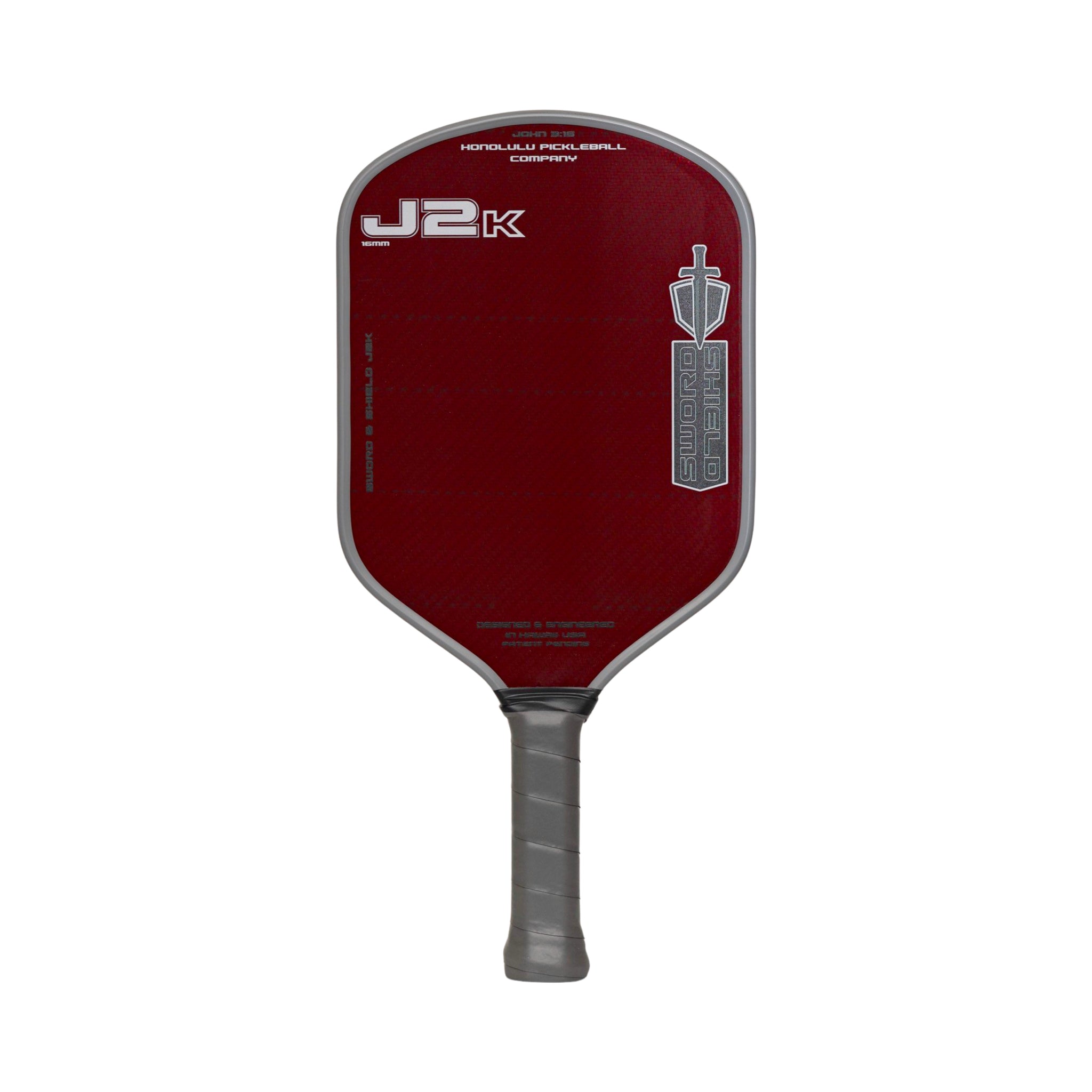Honolulu Sword & Shield J2K Review: Forgiving Foam, Big Sweet Spot

By Mason Kelley (4.5 player, veterinary assistant, D3 tennis alum)
The Honolulu Sword & Shield J2K had been buzzing in my local group for weeks before I finally got my hands on it. I’d just finished a morning shift at the vet clinic (yes, I still had dog hair on my scrubs), grabbed my gear, and headed to Fred Thomas Park to meet up with Sophia and Coach Lleyton for a serious test session. From the first warm-up dink, I could feel why people call this paddle a “confidence machine.”
Specs & Design Overview
- Price: Upper-mid premium tier
- Weight: ~7.9–8.2 oz
- Length × Width: elongated/hybrid profile
- Thickness: 14 mm foam core
- Handle Length: ~5.3″ • Grip: ~4.125″
- Face: raw carbon construction
- Warranty: 1 year + trial period
The J2K’s design feels purposeful: a larger-than-average sweet spot, clean raw carbon face, and foam core tuned for forgiveness—no flashy graphics — just understated confidence.
Performance Breakdown
Power & Pop
This isn’t a bazooka. Drives have enough pace to pressure opponents, but you won’t be blowing balls through people like you would with a Selkirk Power Air. Lleyton joked, “This paddle rewards smart players, not just bangers.” I noticed overheads still had enough juice to finish points, especially if I set them up with spin first.
Spin
The combination of carbon surface and foam dwell time worked beautifully. I was rolling topspin dinks like I was back on the tennis baseline. Sophia, who usually struggles to get heavy spin, said, “I actually hooked a ball around the post for the first time in my life with this thing.” That’s a win in my book.
Control & Touch
Drops and resets felt automatic once I adjusted. Out of the box, it played a little hotter than Sophia expected, but after two games she said it “started to feel like training wheels for my short game.” For me, the touch was intuitive — not too plush, not too crisp.
Forgiveness & Sweet Spot
This is where the J2K shines. Mishits still carried enough depth to stay in play. I had a rally where I was late to two counters in a row, hit both off the edge, and somehow both balls dropped in. Lleyton laughed, “That paddle just saved your hide.”
Maneuverability (Hand Speed)
At the kitchen, I had no issue keeping up. The swingweight is balanced — not feather-light, but quick enough that I never felt jammed. Sophia loved this in doubles exchanges, saying she finally felt like she wasn’t “swinging a club” at the net.
Stability & Feel
Despite being forgiving, it never felt hollow. Blocks against heavy drives were rock-solid. Foam really shines here: no harsh vibration, just a connected, arm-friendly response. My elbow thanked me after three hours of play.
Playtester Feedback
Lleyton (5.0 coach): “This isn’t the paddle you use if you’re trying to end points in one shot. But if you like to construct points with spin and consistency, it’s a weapon.”
Mason (4.5 author): “Coming from tennis, the J2K felt like an old friend. Spin was there, control was there, and my doubles consistency went up. I’ll keep a power paddle in my bag, but this one’s going to see plenty of court time.”
Comparisons & Alternatives
- Vs CRBN Genesis 4: Genesis has more spin ceiling and slightly faster hands, but J2K is friendlier and more forgiving.
- Vs Diadem Warrior Blue Core: Warrior offers more plow-through and counter-punching stability, but J2K is easier for intermediates to trust.
Who Should Use This Paddle?
- Great fit for: Intermediates and advanced rec players who want forgiveness + spin in one package.
- Not ideal for: Power-first hitters seeking max put-away juice.
Conclusion & Final Thoughts
The Honolulu Sword & Shield J2K is less about fireworks and more about giving you confidence to play your best pickleball. With its big sweet spot, friendly spin, and forgiving nature, it’s the paddle that keeps rallies alive and lets you win points with consistency and smarts. For many players, that’s worth more than raw heat.
FAQs
Q: Is the Honolulu J2K USAP approved?
Yes — it’s on the official USA Pickleball approved list. Always double-check before a tournament, but you’re good to go.
Q: How does it feel compared to polymer-core paddles?
Foam feels denser and more connected. Instead of the “plastic thwack” of polymer, you get a solid, muted response. My elbow and shoulder both noticed the difference after long sessions.
Q: Can I add lead tape?
Absolutely. In fact, Lleyton slapped a few grams at 10 & 2 o’clock and said it made the sweet spot feel “as wide as the Pacific.”
Q: Is this paddle good for singles?
It depends on your style. If you rely on spin and consistency to grind opponents down, yes. If you want raw first-strike power, you might prefer something like the JOOLA Perseus.
Q: Why is it called Sword & Shield?
The “Sword” is the spin and offensive potential; the “Shield” is the forgiveness and stability. Honestly, it lives up to the name — you can press the attack or defend comfortably.
Q: Who’s this paddle not for?
If you’re a beginner who struggles to even get the ball over, the price might sting and you won’t unlock its full potential. And if you’re a 5.0 power hitter, you might miss the extra pop.
- Hunter Johnson: From Tennis Twin to Pickleball Singles King - October 2, 2025
- Honolulu Sword & Shield J2K Review: Forgiving Foam, Big Sweet Spot - September 10, 2025
- Paddle Review: The Selkirk VANGUARD Power Air Invikta - September 15, 2023












